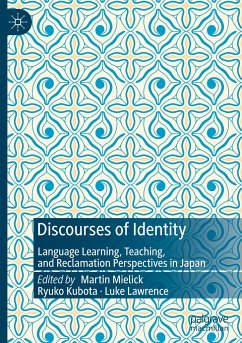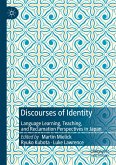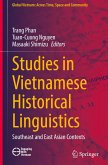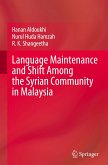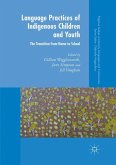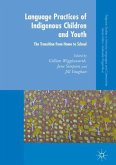Discourses of Identity
Language Learning, Teaching, and Reclamation Perspectives in Japan
Herausgegeben:Mielick, Martin; Kubota, Ryuko; Lawrence, Luke
Discourses of Identity
Language Learning, Teaching, and Reclamation Perspectives in Japan
Herausgegeben:Mielick, Martin; Kubota, Ryuko; Lawrence, Luke
- Gebundenes Buch
- Merkliste
- Auf die Merkliste
- Bewerten Bewerten
- Teilen
- Produkt teilen
- Produkterinnerung
- Produkterinnerung
This edited book draws on research on identity in language education to present a detailed and multi-faceted study of identity in language learning, teaching and revitalization settings in the context of Japan. It employs a diverse range of theoretical approaches, including poststructuralism, critical realism, cognitive behavioral theory, and complexity theory,, as well as methodologies such as linguistic ethnography, narrative enquiry, and critical multimodal discourse analysis. The authors focus on multiple dimensions of identity, illuminating linguistic, cultural and human complexity as…mehr
Andere Kunden interessierten sich auch für
![Discourses of Identity Discourses of Identity]() Discourses of Identity112,99 €
Discourses of Identity112,99 €![Feedback in L2 English Writing in the Arab World Feedback in L2 English Writing in the Arab World]() Feedback in L2 English Writing in the Arab World75,99 €
Feedback in L2 English Writing in the Arab World75,99 €![Japanese at Work Japanese at Work]() Japanese at Work43,99 €
Japanese at Work43,99 €![Studies in Vietnamese Historical Linguistics Studies in Vietnamese Historical Linguistics]() Studies in Vietnamese Historical Linguistics112,99 €
Studies in Vietnamese Historical Linguistics112,99 €![Language Maintenance and Shift Among the Syrian Community in Malaysia Language Maintenance and Shift Among the Syrian Community in Malaysia]() Hanan AldoukhiLanguage Maintenance and Shift Among the Syrian Community in Malaysia89,99 €
Hanan AldoukhiLanguage Maintenance and Shift Among the Syrian Community in Malaysia89,99 €![Language Practices of Indigenous Children and Youth Language Practices of Indigenous Children and Youth]() Language Practices of Indigenous Children and Youth97,99 €
Language Practices of Indigenous Children and Youth97,99 €![Language Practices of Indigenous Children and Youth Language Practices of Indigenous Children and Youth]() Language Practices of Indigenous Children and Youth97,99 €
Language Practices of Indigenous Children and Youth97,99 €-
-
-
This edited book draws on research on identity in language education to present a detailed and multi-faceted study of identity in language learning, teaching and revitalization settings in the context of Japan. It employs a diverse range of theoretical approaches, including poststructuralism, critical realism, cognitive behavioral theory, and complexity theory,, as well as methodologies such as linguistic ethnography, narrative enquiry, and critical multimodal discourse analysis. The authors focus on multiple dimensions of identity, illuminating linguistic, cultural and human complexity as manifested in language teaching and learning. This book will be of interest to advanced students and scholars of TESOL, applied linguistics, education, Japanese studies, East Asian studies, linguistic anthropology, indigenous languages and sociolinguistics.
Produktdetails
- Produktdetails
- Verlag: Palgrave Macmillan / Springer International Publishing / Springer, Berlin
- Artikelnr. des Verlages: 978-3-031-11987-3
- 1st edition 2022
- Seitenzahl: 400
- Erscheinungstermin: 8. Februar 2023
- Englisch
- Abmessung: 216mm x 153mm x 26mm
- Gewicht: 628g
- ISBN-13: 9783031119873
- ISBN-10: 3031119878
- Artikelnr.: 64235438
- Herstellerkennzeichnung Die Herstellerinformationen sind derzeit nicht verfügbar.
- Verlag: Palgrave Macmillan / Springer International Publishing / Springer, Berlin
- Artikelnr. des Verlages: 978-3-031-11987-3
- 1st edition 2022
- Seitenzahl: 400
- Erscheinungstermin: 8. Februar 2023
- Englisch
- Abmessung: 216mm x 153mm x 26mm
- Gewicht: 628g
- ISBN-13: 9783031119873
- ISBN-10: 3031119878
- Artikelnr.: 64235438
- Herstellerkennzeichnung Die Herstellerinformationen sind derzeit nicht verfügbar.
¿Martin Mielick is Senior Lecturer at the English Language Institute at Kanda University of International Studies, Chiba, Japan. Ryuko Kubota is Professor in the Department of Language and Literacy Education in the Faculty of Education at the University of British Columbia, Canada. Luke Lawrence is an English Lecturer in the Department of Sociology at Toyo University, Japan.
Introduction: Language learner and teacher identity in multilingual Japan (Ryuko Kubota).- Part I: English Language Learner Identity.- Chapter 1: English language learners' discursive constructions of national and global identities in the Japanese university context (Martin Mielick).- Chapter 2: It's because I'm Japanese': Examining L2 learners' core beliefs and silent behaviour using a cognitive-behavioural theory-based approach (Kate Maher).- Chapter 3: Becoming the paths we tread: Learning through an ideological landscape of practice (Daniel Hooper).- Chapter 4: Constructing linguistic identity under native-speakerism: A case study of a migrant student studying English in Japan (Xinqi He).- Part II: Japanese Language Learner Identity.- Chapter 5: Am I a nurse? Conflicts in the professional identities of three Indonesian nurses who came to Japan through an Economic Partnership Agreement (Chiharu Shima).- Chapter 6: Language Learning as a Shelter: Restoring a Positive Self-Image by Learning a Second Language (Kazuhiro Yonemoto).- Chapter 7: No need to invest in the Japanese language?': The changes of career choices and identities for plurilingual Chinese students in Japan (Keiko Kitade).- Chapter 8: Who speaks yasashii nihongo for whom?: Reimagining the socially constructed 'beneficiary' and the 'benefactor' identities of plain Japanese for 'foreigners' (Noriko Iwasaki).- Chapter 9: A discursive construction of Nikkei identity and interculturality: Official hybridity, constructed desire, and a masked heterogeneity (Kyoko Motobayashi).- Part III: Indigenous Language Revitalization and Identity.- Chapter 10: The process of constructing and reclaiming Ainu identity: the Urespa project initiative (Yumiko Ohara & Yuki Okada).- Chapter 11: In search of Indigenous identity through re-creation of Ainu self-sustaining community: praxis and learning in action (Tatsiana Tsagelnik).- Chapter 12: New Speakers of Ryukyuan languages: Negotiation, Construction and Change of Identities (Madoka Hammine).- Chapter 13: Against the odds: Second language learners of Ryukyuan (Patrick Heinrich & Giulia Valsecchi).- Part IV: English Language Teacher Identity.- Chapter 14: Ideology, emotion and identity: The impact of English-only policies on Japanese English teachers in Japan (Luke Lawrence).- Chapter 15: Discursive positioning of the Philippines and Filipino teachers in the Skype eikaiwa industry (Misako Tajima).- Chapter 16: 'It feels like I'm stuck in a web sometimes': The culturally emergent identity experiences of a queer assistant language teacher in small-town Japan (Ashley R. Moore).- Chapter 17: Identity and the emotions of non-Japanese university teachers of English in Japan (Sam Morris).- Chapter 18: Going beyond the binary: Translingual teacher identity negotiation through translanguaging practice (Yuzuko Nagashima).- Chapter 19: Frames, ideologies, and the construction of professional identities among non-Japanese EFL teachersin Japan (Robert J. Lowe).
Introduction: Language learner and teacher identity in multilingual Japan (Ryuko Kubota).- Part I: English Language Learner Identity.- Chapter 1: English language learners' discursive constructions of national and global identities in the Japanese university context (Martin Mielick).- Chapter 2: It's because I'm Japanese': Examining L2 learners' core beliefs and silent behaviour using a cognitive-behavioural theory-based approach (Kate Maher).- Chapter 3: Becoming the paths we tread: Learning through an ideological landscape of practice (Daniel Hooper).- Chapter 4: Constructing linguistic identity under native-speakerism: A case study of a migrant student studying English in Japan (Xinqi He).- Part II: Japanese Language Learner Identity.- Chapter 5: Am I a nurse? Conflicts in the professional identities of three Indonesian nurses who came to Japan through an Economic Partnership Agreement (Chiharu Shima).- Chapter 6: Language Learning as a Shelter: Restoring a Positive Self-Image by Learning a Second Language (Kazuhiro Yonemoto).- Chapter 7: No need to invest in the Japanese language?': The changes of career choices and identities for plurilingual Chinese students in Japan (Keiko Kitade).- Chapter 8: Who speaks yasashii nihongo for whom?: Reimagining the socially constructed 'beneficiary' and the 'benefactor' identities of plain Japanese for 'foreigners' (Noriko Iwasaki).- Chapter 9: A discursive construction of Nikkei identity and interculturality: Official hybridity, constructed desire, and a masked heterogeneity (Kyoko Motobayashi).- Part III: Indigenous Language Revitalization and Identity.- Chapter 10: The process of constructing and reclaiming Ainu identity: the Urespa project initiative (Yumiko Ohara & Yuki Okada).- Chapter 11: In search of Indigenous identity through re-creation of Ainu self-sustaining community: praxis and learning in action (Tatsiana Tsagelnik).- Chapter 12: New Speakers of Ryukyuan languages: Negotiation, Construction and Change of Identities (Madoka Hammine).- Chapter 13: Against the odds: Second language learners of Ryukyuan (Patrick Heinrich & Giulia Valsecchi).- Part IV: English Language Teacher Identity.- Chapter 14: Ideology, emotion and identity: The impact of English-only policies on Japanese English teachers in Japan (Luke Lawrence).- Chapter 15: Discursive positioning of the Philippines and Filipino teachers in the Skype eikaiwa industry (Misako Tajima).- Chapter 16: 'It feels like I'm stuck in a web sometimes': The culturally emergent identity experiences of a queer assistant language teacher in small-town Japan (Ashley R. Moore).- Chapter 17: Identity and the emotions of non-Japanese university teachers of English in Japan (Sam Morris).- Chapter 18: Going beyond the binary: Translingual teacher identity negotiation through translanguaging practice (Yuzuko Nagashima).- Chapter 19: Frames, ideologies, and the construction of professional identities among non-Japanese EFL teachersin Japan (Robert J. Lowe).

